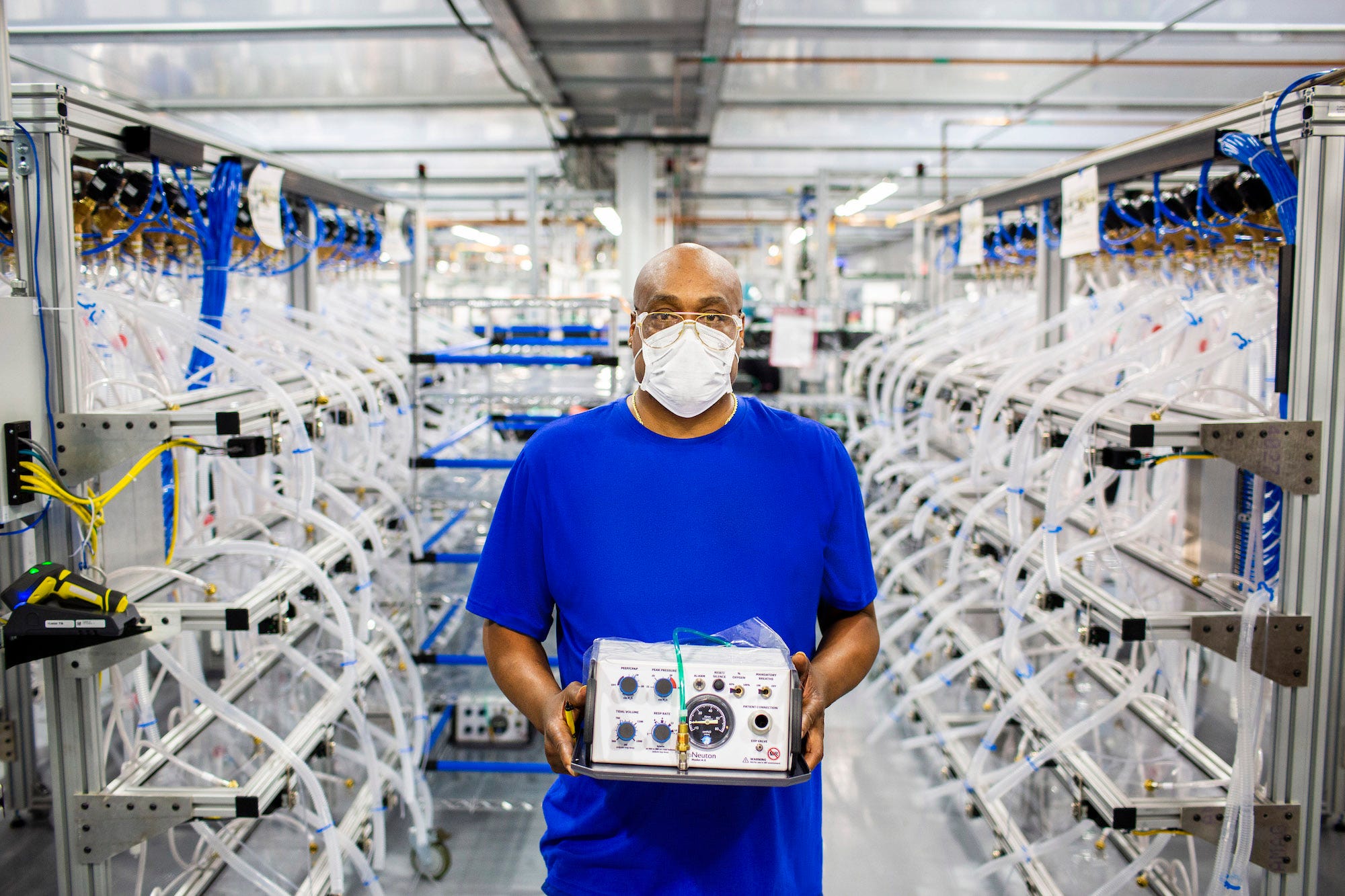- Director Peter Berg worked with Ford and the UAW to make “On the Line”, a short documentary about the company and the union’s joint effort to produce millions of face masks and other protective gear, as well as 50,000 ventilators, as the coronavirus pandemic was raging in early 2020 and Ford’s factories were shut down.
- Within weeks, Ford and the UAW devised a plan to bring volunteer workers to facilities to produce the urgently needed medical technology, using existing Ford materials and manufacturing expertise.
- Rory Gamble, the UAW’s president, had been on the job only a few months when the pandemic crisis hit.
- “He flawlessly rose to the occasion,” Hackett said of Gamble’s determination to keep the UAW membership safe while also fighting the virus.
- “It’s an example of the very best within us, as a country, as workers, and for Ford as a company,” Berg said.
- Visit Business Insider’s homepage for more stories.
When the coronavirus pandemic hit the US hard in March, Ford and every other major global automaker had to shut down production, taking the unprecedented step of idling assembly lines nationwide to protect workers from COVID-19.
At the same time, as the virus ripped through American society, sickening thousands, hospitals faced shortages of protective gowns, gloves, face masks and shields, respirators, and — for critically ill patients — ventilators.
Ford had been making pickup trucks and SUVs at its factories, so the company dusted off its World War II playbook and shifted gears. But this time around, instead of tanks and warplanes, the Blue Oval and its workers made medical equipment.
About five months and 50,000 ventilators later, the effort has been chronicled in a short film, "On the Line", directed by Hollywood veteran Peter Berg, known for films such as "Friday Night Lights" and "Hancock." The eight-and-a-half-minute documentary debuted at Aspen Ideas Now (an extension of the Aspen Ideas Festival) on Friday.
The new UAW president steps up to the challenge

Ford CEO Jim Hackett and GE Healthcare executives oversaw what the companies called "Project Apollo," a name inspired by the movie "Apollo 13," which celebrated American engineering ingenuity under the extreme stress of a failed 1970 Moon mission when NASA fought to return three astronauts to Earth after an accident damaged their spacecraft.
An unsung hero of the story was Rory Gamble, the new president of United Auto Workers, who had been on the job less than six months when the pandemic struck, and was dealing with his members' concerns about workplace safety while simultaneously managing the fallout of a leadership crisis at the union. (His predecessor, Gary Jones, had stepped down amid a scandal and later pled guilty to embezzlement charges.)
The UAW and the Detroit Big Three â€" Ford, General Motors, and Fiat Chrysler Automobiles â€" are often thought to be adversaries. And the differences between labor and management had exploded in late 2019, when the almost 50,000 UAW members walked out on GM, striking for more than a month.
But the Ford effort (as well as a similar undertaking at GM) showed that Detroit's leaders, on both sides, could put aside their differences to "take care of each other," as Gamble said in an interview with Business Insider.
"He flawlessly rose to the occasion," Hackett said of Gamble's determination. "He saved a bunch of people's lives and deserves a ton of credit."
Gamble had been instrumental in pushing for factory shutdowns in mid-March, advocating for his membership. In the span of a week, the Detroit automakers and the UAW went from talking about how they would deal with the coronavirus crisis to idling plants in the US.
Hackett acknowledged that the pressure was a good thing. He estimated that Ford could have lost nearly 3,000 workers to the disease if the company hadn't swiftly pulled the plug.
"We got them out of the exposure path," Hackett said, calling the undertaking a phenomenal effort by Ford and the UAW. His praise for Gamble was unflinching. "I'd love to sit across the table from him," Hackett said.
"We set a common goal and left our differences behind," Gamble said, adding that the UAW and Ford approached the pandemic from a "humanitarian perspective."
"The entire world is fighting this virus," he noted. "It's a threat to all life, so all life should be fighting it collectively."
Enter the Hollywood storyteller

The story captured the attention of Berg, who had already been working on a project with Ford and Hackett about how the 117-year-old company was reinventing itself for the 21st century. So he set about following Ford workers and executives as they repurposed numerous automotive components to make millions of masks and face shields and tens of thousands of ventilators, at a pace Hackett called "mind-boggling." (UAW members volunteered to work at facilities that had to be revamped to make the medical technology.)
"There wasn't a lot of shaping that had to be done," Berg said of the narrative, which features longtime Ford employees talking about their commitment to the company and its history, but also to the virus-beleaguered public and to front-line medical personnel and emergency workers.
"It's an example of the very best within us, as a country, as workers, and for Ford as a company."
Berg agreed that he had filmed a distinctly American story.
"We're desperate for these stories today. Cynicism is at levels I haven't seen in my lifetime. But this is an undeniable example of American ingenuity. I had an authentic, no-BS opportunity to document that."
http://www.youtube.com/watch?v=lYHgV2u1T2Y
